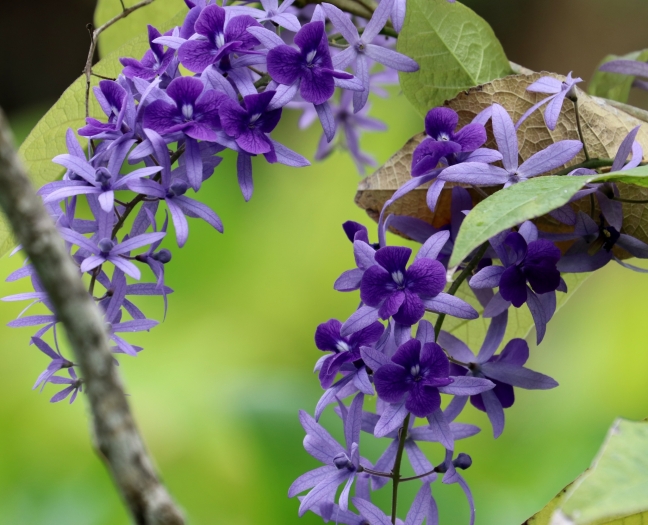Queen’s-Wreath
(Petrea volubilis)
Queen’s-Wreath (Petrea volubilis)
/
/

Aitor
CC BY 4.0
Image By:
Aitor
Recorded By:
Copyright:
CC BY 4.0
Copyright Notice:
Photo by: Aitor | License Type: CC BY 4.0 | License URL: http://creativecommons.org/licenses/by/4.0/ | Rights Holder: Aitor | Publisher: iNaturalist | Date Created: 2019-05-29T15:17:26Z |




















































Estimated Native Range
Summary
Petrea volubilis, commonly known as Queen’s-Wreath or Purple-Wreath, is an evergreen vine native to the dry forests and scrublands of Mexico, South America, Central America and the Caribbean. It can also be found in tropical deciduous forests. This species is known for its striking cascades of violet to blue flowers, which resemble those of wisteria, and its woody, twining growth habit. It can reach up to 12 meters when supported as a climber or be maintained as a shrub up to 4 meters tall. The flowers, highly attractive to pollinators, emerge from persistent, papery bracts and can bloom twice a year in optimal conditions. The vine’s foliage is dark green and leathery, adding to its ornamental value.
Queen’s-Wreath is celebrated for its long-lasting and showy floral displays, making it a popular choice for arbors, trellises, and fences in warm climates. It is also used as a free-standing shrub in garden borders. This plant is relatively low-maintenance, requiring minimal care once established. It is drought-tolerant and thrives in well-drained, fertile soils. While it prefers full sun for optimal flowering, it can tolerate partial shade. However, it is sensitive to frost and should be protected or grown in containers in regions where temperatures can drop below -2 °C. In areas where it is not hardy, it can be grown as a houseplant or in a greenhouse. Potential problems include susceptibility to scale insects and mealybugs.CC BY-SA 4.0
Queen’s-Wreath is celebrated for its long-lasting and showy floral displays, making it a popular choice for arbors, trellises, and fences in warm climates. It is also used as a free-standing shrub in garden borders. This plant is relatively low-maintenance, requiring minimal care once established. It is drought-tolerant and thrives in well-drained, fertile soils. While it prefers full sun for optimal flowering, it can tolerate partial shade. However, it is sensitive to frost and should be protected or grown in containers in regions where temperatures can drop below -2 °C. In areas where it is not hardy, it can be grown as a houseplant or in a greenhouse. Potential problems include susceptibility to scale insects and mealybugs.CC BY-SA 4.0
Plant Description
- Plant Type: Vines
- Height: 6-12 feet
- Width: 3-6 feet
- Growth Rate: Moderate
- Flower Color: Purple
- Flowering Season: Spring, Summer
- Leaf Retention:
Growth Requirements
- Sun: Full Sun, Part Shade
- Water: Medium
- Drainage: Medium
Common Uses
Bee Garden, Bird Garden, Butterfly Garden, Drought Tolerant, Hummingbird Garden, Potted Plant, Salt Tolerant, Showy Flowers
Natural Habitat
native to the dry forests and scrublands of Mexico, South America, Central America and the Caribbean
Other Names
Common Names: Purple-Wreath , Sandpaper , Sandpaper Vine , Nilmani , Propellerbuske
Scientific Names: Petrea volubilis , Petrea racemosa , Petrea arborea , Petrea kohautiana , Petrea subserrata , Petrea aspera , Petrea nitidula , Petrea amazonica , Petrea rivularis , Petrea colombiana
GBIF Accepted Name: Petrea volubilis L.